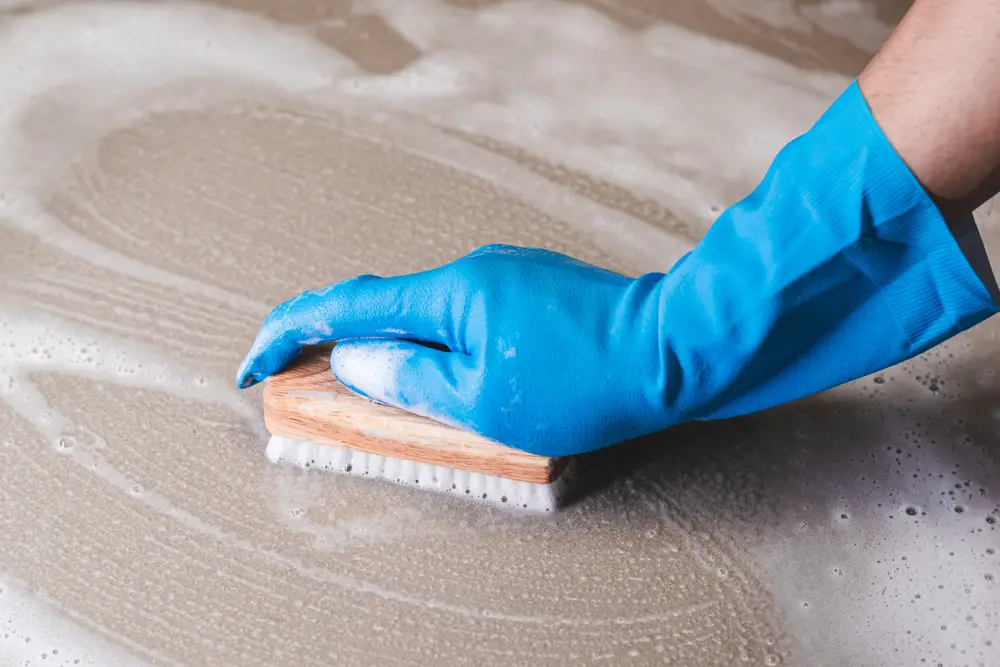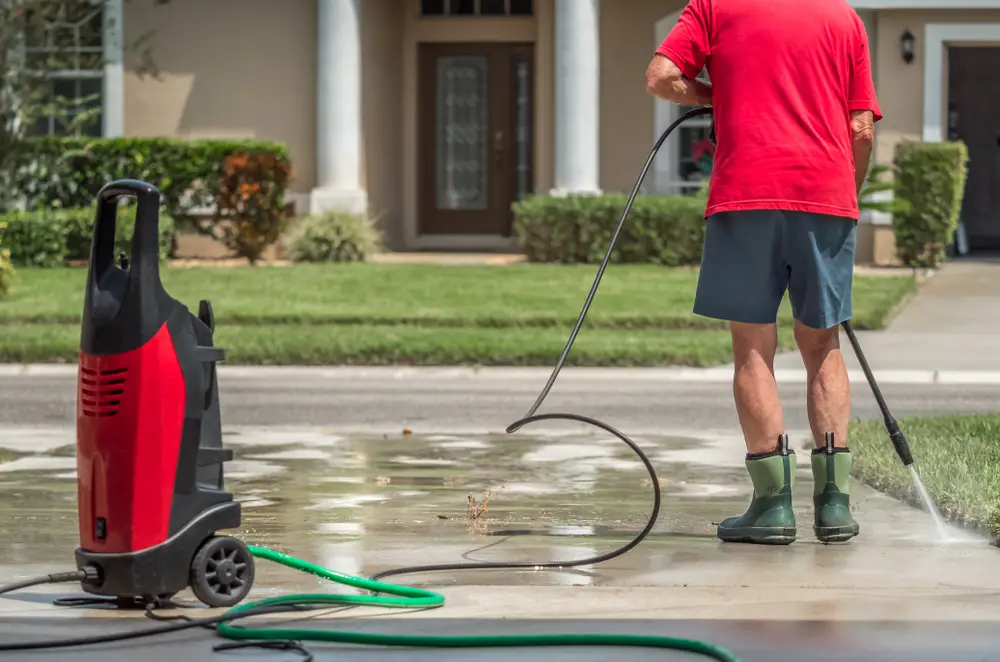With the increasing popularity of exposed concrete surfaces in modern and contemporary architecture, there is a simultaneous increase in water stains occurring on said surfaces. Water stains generally occur on concrete when the surface is constantly exposed to a water source and the concrete has not been recently sealed or never was.
There are several methods to remove water stains from concrete; these involve various chemicals in different ratios with water. Some examples of the chemicals used include vinegar, Hydrochloric Acid, Lime-Away, Trisodium Phosphate, and in some cases, baking soda or fluoride toothpaste.
However you go about removing the stains from your concrete surfaces, you should be able to find a method that results in success for your stain removal goals. It’s also important to understand the potential causes of concrete water stains in the first place to put measures in place to prevent the concrete from being stained again.
How To Remove Water Stains From Concrete

The good news here is that water stains are among the easier stains to remove from concrete, especially when compared to leaf stains. There are several methods available to help you remove water stains from your concrete surface, irrespective of what caused the stain in the first place.
To begin with, you will need to clean the immediate area and remove any debris from the surface.
Liquid Laundry Detergent
Next, try the easiest and quickest solution, spot treating the stains as necessary. Simply pour liquid laundry detergent over the stained area and then scrub the stain using a stiff nylon brush (brushes with wire bristles will scratch the concrete).
Once you have scrubbed the stain sufficiently, rinse off the soap using fresh water and then allow the area to dry.
Vinegar
If your stain has not disappeared after trying the laundry detergent method, your next option is to use a solution of water and vinegar. Using a spray bottle, fill half the bottle with water and half with vinegar. Spray the water spots using the vinegar solution you have just made, ensuring the stains are completely saturated.
Allow the vinegar cleaning solution to sit on the stains for at least twenty minutes. This will give the vinegar a chance to work into the concrete. Next, begin scrubbing the stained portions of concrete using a scrubbing brush with nylon bristles. If the solution happens to dry completely, feel free to spray more for higher effectiveness.
Alternatively, you can opt out of diluting the vinegar and use it as-is on the stain. Pour a second coat of vinegar after the first has had twenty minutes to soak on the stain, and scrub vigorously.
Once complete, rinse the concrete using clean water from a bucket or hose. Once the surface has dried completely, inspect the area for stains. You can repeat the above process for any stubborn stains, however, this is very rarely ever necessary.
Lime-Away
If there is still a stain on the concrete surface, you may need to use a product such as Lime-Away to fully remove the build-up of mineral deposits. Simply apply the Lime-Away product to the stain and allow it to act for five minutes.
Next, vigorously scrub the stain covered in Lime-Away. For best results, pour clean water over while scrubbing the stain to start diluting the chemical. Please note that if Lime-Away is not diluted and ultimately rinsed off, it can also start to cause stains on the surface.
Trisodium Phosphate
Another alternative method for cleaning water stains is to use Trisodium Phosphate. This is especially effective on stamped concrete or decorative concrete.
Please ensure that you are wearing rubber gloves so that your hands are properly protected from the chemicals. It’s also important to keep in mind that trisodium phosphate is a harsher product than the above forementioned options, however, it is still a safer alternative compared to hydrochloric acid.
Make a solution using 1 pound of trisodium phosphate and 5 gallons of warm water. You will need to work the chemical solution into the concrete stain, preferably with a nylon brush. You can also use trisodium phosphate in conjunction with a pressure washer for even better results.
Once you have allowed the trisodium phosphate to rest on the concrete for 10-20 minutes you can rinse off with water.
Pressure Washer

Another method that does not rely on strong chemicals is a pressure washer. Pressure washers are outstanding tools that offer a wide variety of applications, however, homeowners must have a good sense of what PSI they can use. Blasting your concrete using too much PSI is a fast way to degrade it. Your average exterior concrete can handle 1800-2300 PSI. Avoid using your pressure washer at a higher PSI than this range.
Pressure washers can be purchased or rented. Alternatively, you can also purchase an attachment that will allow you to convert your ordinary garden hose into a pressure washer, however, these will not be as effective as a pressure washer.
You can check out our personally-tested review on the best electric pressure washers here!
Hydrochloric Acid
An alternative method – albeit a lot harsher than a product such as lime-away – is to use hydrochloric acid to remove water stains from concrete surfaces. We think of hydrochloric acid as our solution of last resort. Don’t get me wrong, it is an outstanding product in terms of its effectiveness, but it also comes with safety considerations and it is a relatively nasty chemical, so we like to turn to this when nothing else has worked.
To work safely with this chemical, you will need to wear rubber gloves. It’s also a good idea to wear a respirator and eye protection.
Ensure the area is as well-ventilated as possible before using hydrochloric acid. Next, make your cleaning solution. Your solution should have 1 part hydrochloric acid to 9 parts water. Be sure to add the water before you add the acid.
Begin by dampening the stain on the concrete before applying the acid onto it. Scrub vigorously (always using a nylon brush) and allow it to fizz before rinsing it with clean water.
Please note: When using Hydrochloric acid, ensure that any plants nearby are properly protected and try to limit runoff. Hydrochloric acid can kill surrounding plants and it should be handled carefully.
What Causes Water Stains On Concrete?
Water stains on concrete are generally caused by exposing the concrete to a constant moisture source. The stains result from a build-up of minerals from the untreated water. Potential problematic water sources can include a leaky faucet, damp laundry, or a leaky seal around a plumbing fixture.
Another common cause of water stains on concrete is pot plants that constantly leak or drip water onto the concrete below. The minerals in the water leave behind stains on the concrete. This staining potential is made worse if there are fertilizers in the water.
How To Prevent Hard Water Stains On Concrete
The most effective way to prevent water stains on your concrete surfaces is to eliminate any leaks that might force the concrete to be constantly exposed to moisture. This stain-preventing solution could be as simple as fixing a leak or moving a pot plant to a different spot.
Alternatively, you can cure and seal the concrete surface after cleaning to help prevent stains from re-occurring. There are several types of sealants and options to consider when considering sealing your concrete. Check out this article where we discuss leaf stain prevention and sealing outdoor concrete.
Conclusion
Irrespective of how your concrete became water-stained, you will find a method that works effectively to remove the unsightly stains from your concrete surfaces. Once you have found a cleaning method that works for you, ensure that you take the necessary measures to prevent the stains from resurfacing for as long as possible.
Sources
https://www.thespruce.com/how-to-remove-and-prevent-concrete-efflorescence-845101
https://www.hometalk.com/diy/clean/house/q-hard-water-stains-on-concrete-22613108
https://www.forconstructionpros.com/concrete/article/21135029/the-quikrete-companies-what-is-efflorescence-how-to-prevent-treat-and-remove-white-discoloration-from-concrete